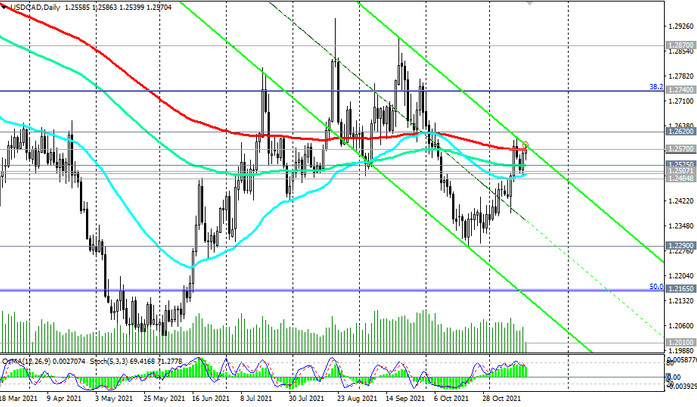Yesterday's report by the US Census Bureau increased the upward pressure on the dollar. As follows from this report, the volume of retail sales in the US increased by +1.7% in October, higher than the forecasted value of +1.4% and the previous +0.8%. The data presented clearly shows that American consumers continue to spend money, despite the fall in consumer confidence (the consumer confidence index from the University of Michigan, published last Friday, in November fell to 66.8 after falling to 71.7 last month). The US consumer sentiment index has dropped to its lowest level in a decade as rising inflation puts pressure on that sentiment, economists say. At the same time, despite the drop in consumer confidence, consumers are in no hurry to cut costs significantly.
The recovery in consumption, in turn, leads to a shortage of goods and their rise in prices and, accordingly, to an increase in inflation. As follows from the report published on Tuesday by the US Department of Labor, the export price index rose by +1.5% in October (against the forecast of +0.9% and the previous value of +0.4%). The import price index rose by +1.2%, which also turned out to be higher than the forecast of +1.0% and the previous value of +0.4%.
The consumer price indices (CPI) released last week provided further evidence that core inflation in the US is high and growing, including on the sentiment of Fed leaders, who are gradually leaning towards an earlier start of interest rate hikes.
Inflationary expectations of US consumers for the next 12 months rose to 4.9% from 4.8% in October and is 2.9% for the next five years. In view of this, according to economists, the dollar will remain strong due to strengthening expectations for an increase in the US key interest rate.
This is evidenced, in particular, by the growing DXY dollar index, which today managed to renew its 16-month high near the mark of 96.26.
Meanwhile, inflation is growing not only in the United States, but, as follows from the incoming macro data, and beyond. Thus, according to data published on Wednesday by the National Bureau of Statistics of Great Britain, the consumer price index (CPI) in October increased by +1.1% after rising by +0.3% in September (+4.2% in annual terms) after growth of +3.1% last month. The core CPI, which excludes volatile food and energy prices, rose +3.4% in October after rising +2.9% in September (on an annualized basis). Inflation in the UK has accelerated, reaching its highest level since December 2011 amid rising energy prices and worsening supply problems. The increase in prices was also observed in the service sector and in transport.
At first, the pound reacted positively to the presented data and strengthened, including against the US dollar. These data indicate increased inflationary pressures, which make it more likely that the Bank of England will raise its key rate in December. However, the positive momentum of the pound weakened further, and the pair GBP / USD dropped to the level of the opening of the trading day.
It is obvious that the US dollar is currently leading the market. More and more market participants are betting on its further strengthening, expecting a more rapid tightening of the Fed's monetary policy. Federal funds futures traders now estimate the likelihood of a rate hike at over 70% by June, up from just over 50% a week ago, according to the CME Group.
Today the volatility in its quotes will increase again, primarily in the USD / CAD pair, when inflation indicators for Canada will be published at 13:30 (GMT). The consumer price index is expected to accelerate in October to +0.7% from +0.2% in September (to +4.7% from +4.4% on an annualized basis). The core consumer price index (Core CPI) from the Bank of Canada, which reflects the dynamics of the retail prices of the corresponding basket of goods and services excluding fruits, vegetables, gasoline, fuel oil, natural gas, mortgage interest, intercity transportation and tobacco products, is expected to be rose +3.5% in October after rising +3.7% in September. Despite the relative decline, this is a high figure as the inflation target for the Bank of Canada is in the 1% -3% range. The rise in CPI is a harbinger of a rate hike and a positive factor for CAD. If economists' expectations come true or the real dynamics of CPI turns out to be stronger, then the Bank of Canada may receive an additional signal for further tightening of monetary policy. If the expected data turns out to be worse than the forecast / previous values, then this will negatively affect the CAD. In any case, during this period of time, a sharp increase in volatility in CAD quotes, and especially in the USD / CAD pair, is expected, since at the same time important information on the dynamics of the country's real estate market will come from the United States.
It is also worth noting that the loonie is losing support from oil prices, which continue to decline today after falling sharply last week. As you know, Canada is the largest exporter of oil, and the share of oil and oil products in the country's exports is approximately 22%.

At the time of publication of this article, the USD / CAD pair is traded near the 1.2570 mark, through which the key long-term resistance level passes (see Technical Analysis and Trading Recommendations). Its confirmed breakdown will lead to further growth in USD / CAD. In any case, in the current situation, one should not expect a significant weakening of the US dollar and a decline in USD / CAD. Although, the market situation and expectations of the Fed's tough actions may also change quickly, and with it the direction of USD dynamics.





